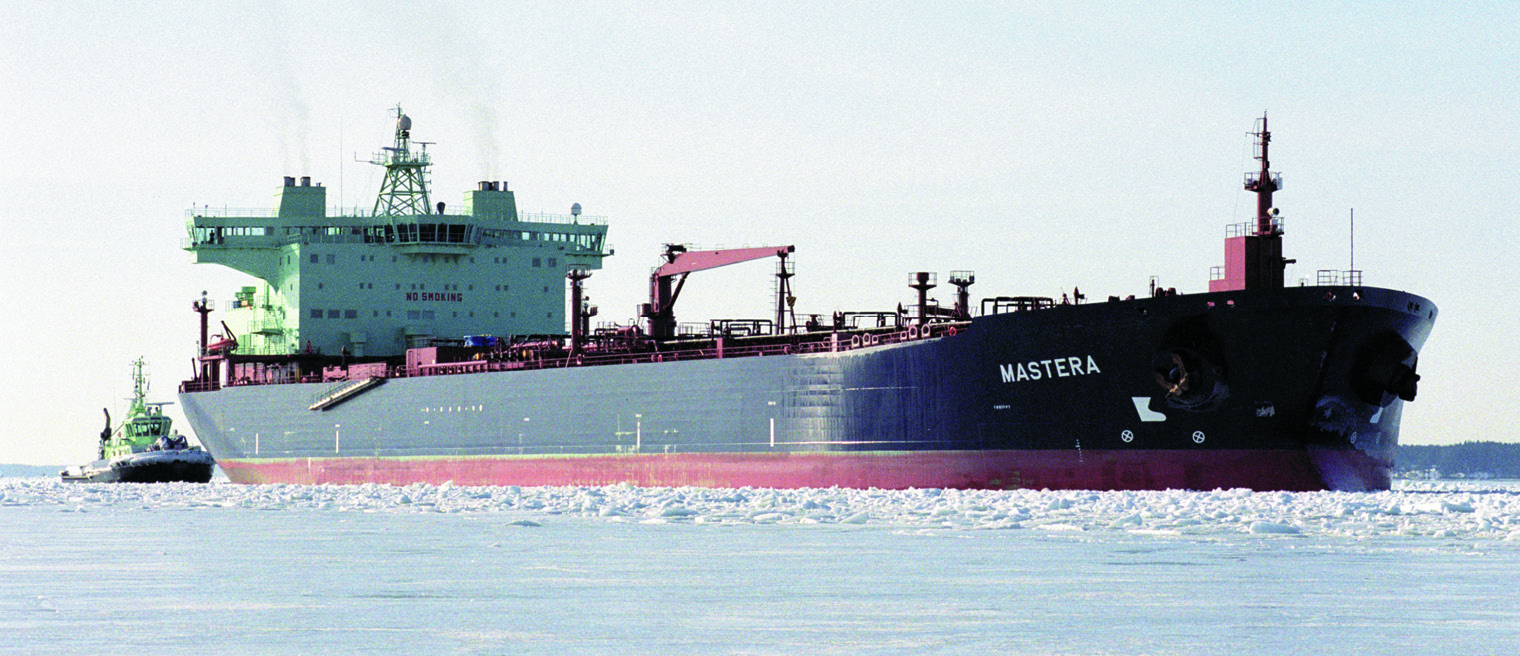

Double-acting tankers TEMPERA and MASTERA for navigating in ice
Two innovative 106,000 dwt crude carriers TEMPERA and MASTERA were built by the Yokosuka shipyard of Sumitomo Heavy Industries Ltd. for the Finnish group Fortum Oil and Gas and they were delivered successfully in August 2002 and January 2003 respectively. The vessels are built according to Double Acting Technology and are fitted with diesel-electric podded azimuthing propulsion system.
The first open sea trial of TEMPERA was conducted in August 2002 at Sagami Bay of Japan. In addition to normal sea trials, several speed performance tests and maneuvering tests at astern condition were carried out and compared with model tests results. Full-scale ice tests of MASTERA were conducted in February 2003 during the voyage between Naantalli, Finland to Primorsk, Russia. Ice experts from Masa-yards Arctic Research Center (MARC) investigated the ice breaking capacity at ballast and fully-loaded conditions.
The principle of the DAT concept is that, like most vessels, it travels ahead on normal open water and thus has a highly hydrodynamic shaped bow and sides. When it sails in ice, however, it travels astern where the reinforced stern hullform is used to break the ice. The podded propulsion system is used to produce a water stream between the ice and the hull, thus lubricating the contact.
The propulsion is provided by an Azipod unit. It contains the electric motor and the fixed pitch propeller. This pod can rotate at 360° and has a maximum rating of 16MW, although the nominal output is 15MW. This gives the tanker a speed of 17 knots in open water. In ice, the tanker can go at 3 knots in 1m thick ice. For port manoeuvring purposes, there is also a bow thruster. ABB supplied the complete electric propulsion system.
The hull structure features a reinforced double skin with a fatigue life of 40 years. A double skin cofferdam protects the bunker tanks and there is also a double bottom protecting the pump room.
The tanker has 12 cargo tanks which are divided by a central bulkhead, as well as two slop tanks, which gives it a capacity of 121,158m3 at 98%.
The tanks are filled and drained by four pumps located in the pump room next to the engine room. There are three electrically-driven cargo oil pumps which operate at a rate of 3500m3/h each. There is also a cargo-stripping pump which works at 300m3/h. Amidships houses the cargo manifold system, which contains three manifolds. A 15t crane with a maximum reach of 8m performs hose handling. Offloading takes 12 hours and requires 17t of fuel. Loading takes ten hours and uses 3.5t.
The epoxy-coated ballast water tanks are located in the side and double bottom tanks. There are 12 tanks surrounding the cargo, and these are separated by a longitudinal bulkhead.There are also two fore and two aft peak tanks. These 16 tanks have a total capacity of 46,944m3. It is possible to carry out an emergency cargo transfer into the double hull. Two electric-powered pumps transfer the ballast water. One pumps at 1500m3/h and the other at 3000m3/h.
There are also three tanks that hold drinking water, fresh water and “technical” water. These have a total holding capacity of 324m3.
There is an inert gas system for the slop and cargo tanks. The cargo and slop tanks have steam heating coils. Two oil-fired boilers with internal water tubes produce the steam.
Power is supplied by five Wärtsilä diesel gensets. They comprise two 6MW 9L38B diesel engines, and two 4MW 6L38B diesel engines (all of which use heavy fuel oil at a rate of 56t/day when at 13.5 knots). They produce 6.6kA of AC current at 60Hz each. It is then fed into a switchboard and onto the cycloconverter which is linked to the pod motor.
For harbour use there is one 1.7MW 6L26A diesel engine. It runs on MDO stored in a 308m3 tank. There is a 63.2m3 tank for lub oil.
Length, oa: 252.00m, Length, bp: 230.00m, Breadth, mld: 44.00m, Depth, mld: 22.50m, Draught design/maximum: 14.50/15.30m, Deadweight maximum: 106,200dwt, Gross tonnage: 64,259, Total power installed: 22,940kW, Service speed at 15,000kW:15.10 knots.
